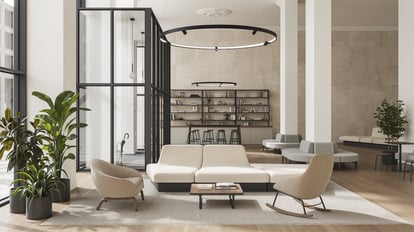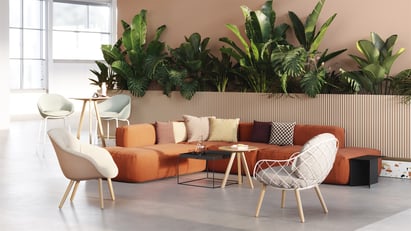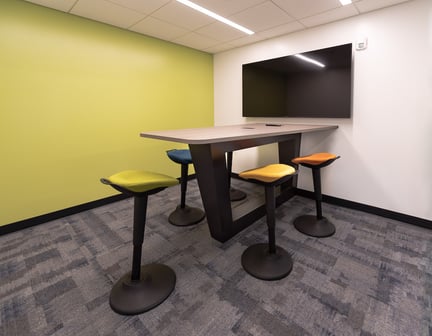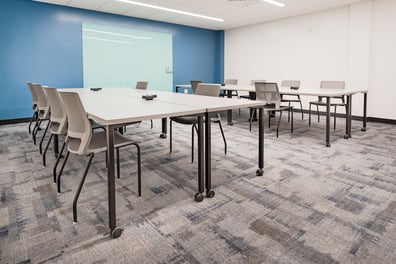Nearly every industry in the U.S. is struggling to attract and retain workers. In an attempt to get noticed in a declining labor pool, companies are boosting wages, increasing benefits, doling out sign-on bonuses, and offering creative perks.
Is it enough?
Incentives might get prospects to fill out an application and maybe even schedule an in-person interview. When they show up at your door, however, will your workplace leave a lasting impression that helps them envision themselves returning again and again as a valued employee?
As difficult as it is to hire, keeping workers for the long term is the real end goal. Providing a dynamic workplace environment can play a major role in capturing their attention and keeping it.

Photo Credit: MillerKnoll
The scientific findings for how long it takes to form a first impression are up for debate, suggesting it can take anywhere from seven to 30 seconds. In either regard, a job candidate who walks up to your lobby will make a judgment call about your workplace and might even decide whether or not they belong there before your receptionist has a chance to say ‘hello.’
The entryway leading up to your building and your interior lobby says a lot about your organization’s brand. Does its physical expression reflect a forward-thinking, vibrant work environment? Or is it screaming, “1987 called and it wants its furniture back?” If it’s the latter, younger recruits in particular will question how innovative your company truly is and whether you’ll embrace their progressive ideas. Updating furnishings and finishes throughout your facility can help show your organization in the best light.
RELATED ARTICLE: The Latest Commercial Interior Design Trends

Photo Credit: MillerKnoll
Many employees became accustomed to working from home during the pandemic. While operations may have remained steadfast, company culture, collaboration, and camaraderie often suffered. Drawing employees back into the office to strengthen your culture will require creating a home-like environment.
Make an intentional effort to provide comfortable seating of their choosing with a combination of ergonomic task chairs and soft lounge chairs. If space allows, design tucked-away seating areas that offer some respite along with budget-conscious laptop tables. Repurpose underutilized offices with expansive windows into comfortable workspaces where all employees can enjoy the natural light, not just your top executives. Accessorize with plants, artwork, pillows, and ancillary furnishings to create an inviting atmosphere.
The goal is to bring pleasing aesthetics and purpose to everyone’s work environment, a place where feelings of obligation are replaced with a sense of anticipation when coming into the office.
Photo Credit: MillerKnoll
Take a hint from college campuses with their commons area, labs, classrooms, and open study halls. They’re designed to foster learning and collaboration and allow for movement throughout the day. It’s also where students build community.
When graduates enter the workforce, however, many are directed to an isolated cubicle with minimal interaction with others. In general, employees don’t want to be tethered to a single workstation. They might want to work alongside others for a portion of the day and then seek some solitude.
With some exceptions, individual offices are becoming a thing of the past. Departments are now encouraged to cross-pollinate to help eliminate silos and create greater appreciation for each other’s contributions. A collaborative office design helps employees come together and create a sense of belonging.
Photo Credit: MillerKnoll
Consider whether conference rooms can be converted into common areas. Herman Miller furnishings, officially MillerKnoll, Inc., conducts studies to determine space utilization. They determined that the average 10-person conference room is rarely filled more than once or twice a month. If that sounds familiar, consider optimizing that real estate.
Understand how and when space is used and embrace a culture of change, flexibility, autonomy, and empowerment to make the area work for you instead of the other way around. A professional design firm like Samuels Group can assess your underutilized space and provide recommendations for enhancing your interior with collaborative furnishings and layouts.

Photo Credit: Gamber-Johnson LLC
With hybrid teams, a company can now have employees in the office or across an ocean. Connectivity is critical as is the ability to interact seamlessly without difficulty. If a supervisor wants to video conference with remote colleagues, they need to have confidence that the technology will work and that the room is set up so that everyone can see and hear each other. Persistent technical issues cause frustration and can lower morale and productivity.
Create consistency across all work areas with video cameras and adequate A/V. Keep technology simple enough so that everyone can use it. Always have your A/V partner and furnishings provider work together to properly integrate technologies with furnishings so that both can be intentionally designed. Too many cords, poorly placed outlets, and inadequate power will only add to frustrations.
Also provide individual spaces with technology and privacy so someone doesn’t take up an entire conference room for a single video call. Look into lounge furniture or pods with acoustic siding and canopies to minimize disruptions.
RELATED ARTICLE: The Relationship Between Power and Furnishings

Photo Credit: Gamber-Johnson LLC
There’s a lot of buzz around flexibility. Employees don’t just care where they work, but when they work. A company’s floor plan also needs to build in flexibility and establish a culture of change and choice. For too long, furnishings and workspaces were in fixed positions. Now, furnishings need to be mobile and able to be stacked, flipped, or moved easily on casters to maximize real estate. The conference room might double as a workspace. A training room may host a dozen employees one hour and be cleared to hold a company-sponsored yoga session the next.
The key is to make smart investments in spaces that can evolve and adapt to meet your business needs while also serving your workforce.
Attraction and retention often get lumped together into one business objective, but they are very different. In addition to your pay and benefits, great amenities, technology, a collaborative culture, and intangible benefits are often what keep great employees around.
Download The Ultimate Guide to Office Furnishings and Design Ideas today to explore how to design a workplace where employees feel like they’re missing out if they don’t come into the office.
These stories on Furniture Solutions